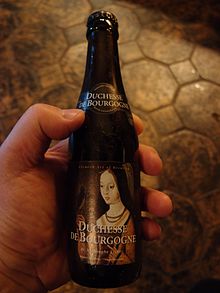 |
Flanders, or Flemish Red ales are sharp, acidic and refreshing, they have fruity flavours and aromas that develop from the malt, yeast and extended aging in large oak vats.
There is some evidence that Flanders Red and English Porter beers share the same heritage, that might seem at odds with the flavours you find in these beers today, but makes more sense when you begin to understand the process for maturing and aging them. Back in the early 19th century Porter was stored and aged in very large wooden barrels, this invariably meant it took on an acidic twang, tart if not fully sour, and at the time this mature beer was known as "stale" and it's younger fresher self as "Mild".
At some point in its evolution it was discovered that mixing an amount of old sour Porter with younger, milder beer would result in the same overall result.Thus the un-blended fresh beer, or Mild and a stronger flavoured or stale beer, could be blended to create Porter, as long as a stock of mature stale beer was maintained. Indeed, it was even shipped to pubs in separate casks and then blended by the barman to suit the taste of his drinking clientele (often unbeknown to them).
The blending of fresh and sour beer is how Flemish or Flanders Red Ales are still produced today, with breweries such as Rodenbach blending various amounts of young and mature beers together to achieve their different beers.
Unfortunately sour beer went out of favour in England and almost all Porter these days is in fact more akin to the original "Mild" beers of the 19th century, although some smaller artisan breweries are starting to produce a more "authentic" version so maybe the style will catch on again in the UK.
The most famous of all Flanders Red Ales is made by Rodenbach, the story goes that in the second half of the 19th century Eugène Rodenbach brought the English Porter brewing methods back to his native Roeselare, while the accuracy of this seems unlikely given that blended Porter was really on the wain in England by 1870, it is certainly true that for whatever reason he began brewing a beer using this approach and a style of beer was born. These days only Rodenbach and Verhaeghe make beer in this traditional way.
 |
| Grain bill, minus some wheat |
My starting point, like many people I guess, was Jamil Zainasheff's recipe in his book "Brewing Classic Styles", it wasn't my only source of information however, there are recipes all over the internet these days, and probably the best article can be found on the BYO site.
Indeed it was that site, plus a few others that encouraged me to adapt the method to hopefully give me the best chance of success.
My grain bill for a 22L batch was as follows:
Ingredients: ------------ Amount Item Type % or IBU 2296.49 gm Pilsner (2 Row) UK (2.0 EBC) Grain 38.90 % 2296.49 gm Vienna Malt (6.9 EBC) Grain 38.90 % 434.21 gm Munich Malt (17.7 EBC) Grain 7.36 % 219.04 gm Aromatic Malt (51.2 EBC) Grain 3.71 % 219.04 gm Caramunich Malt (110.3 EBC) Grain 3.71 % 219.04 gm Special B Malt (354.6 EBC) Grain 3.71 % 219.04 gm Wheat Malt, Ger (3.9 EBC) Grain 3.71 % 26.64 gm Goldings, East Kent [5.00 %] (60 min) Hops 14.2 IBU
This is pretty similar to Jamil's, it's scaled up to suit my efficiency (72% vs the book's assumed 60%) as well as the size of the batch. The key ingredient is the Special B malt, the darkest of all Belgian Caramel Malts, it provides the deep reddy-brown hue that is so recognisable.
The hops were also a year old and so the IBUs are likely to be less than predicted, although recipes give between 10 and 20 IBUs as normal, the lower end should allow the bacteria and wild yeasts at least a fighting chance.
I also had another dilemma, which yeast to use. WLP655 from White Labs or Roeselare Blend from Wyeast. Both have their advocates, but waiting a year to find out which I preferred was too much for me to handle.
To solve this I decided to do a split batch and try both, finding that 3 US Gallon (just over 11 litres) PET carboys were now available, very similar to my 6 US Gal Better Bottle, I ordered a couple, some bungs and two airlocks.
 |
| Racking after four days |
The final tweak was to mash at 70 °C (158 °F), this I did to ensure that there would be plenty of sugars left for the Brettanomyces, Lactobacillus and Pediococcus bacteria to munch on.
I hit all my numbers, having to add 1ltr of previously boiled water to make up for evaporation (90 min boil, longer boils are generally a good idea if using Pilsner Malts as it helps deal with DMS).
The OG of the beer was 1.059, after four days it was 1.019, the beer was still cloudy and sweet tasting, but actually not unlike traditional Mild, I might even be tempted to have a go at an tasty malty session beer using a very similar grain bill, maybe a few more hops and a lower mash temp.
I then racked it into the two new carboys, added the cultures and labelled them up ready for their long hibernation through the winter and next year. I will probably add some oak once I feel it is nearly ready to bottle, but only for a couple of weeks. I also may well end up blending the two beers, or saving one for another year to mature and sour further, it all depends on what happens.
Further reading:
BYO Magazine on Flanders Red
Martyn Cornell on Porter
Beervana visit to Rodenbach

No comments:
Post a Comment